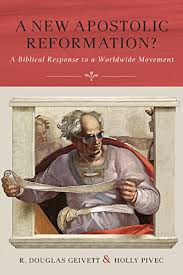
R. Douglas Geivett and Holly Pivec. A New Apostolic Reformation: A Biblical Response to a Worldwide Movement. Bellingham, WA: Lexham Press. 2014. 254 pp.
Introduction
This book surveys the rise of the so-called New Apostolic Reformation (NAR). The NAR movement’s roots can be traced to the 1980s in North America but is now a world-wide phenomenon. The central figure in this movement is the late C. Peter Wagner. Wagner was still living when Geivett and Pivec researched and wrote this book. Wagner passed away on 21 October 2016. Lexham Press published New Apostolic Reformation? in 2014. There are nineteen chapters, a preface, a conclusion, and three appendices. The book is endorsed by a number of Evangelical pastors and scholars. This list of endorsements includes Daniel Wallace, Craig Evans, Amos Yong, and Paul Copan.
Both Geivett and Pivec are connected to Biola University in La Miranda, California in the United States. Geivett is a professor of philosophy at Talbot School and Theology at Biola, and Pivec holds an MA from Biola. Geivett holds a PhD from the University of Southern California. Pivec mentions that her church family is Bethel Church in Fairbanks, Alaska (xvii). The two of them also collaborated on a book entitled God’s Super Apostles: Encountering the Worldwide Prophets and Apostles Movement. This second book was published in 2018.
The authors refer to NAR as a worldwide movement. The also demonstrate that NAR has had international impact. However, the focus of the book is the impact, influence, and response to the NAR movement in North America.
Book Summary
The nineteen chapters in this book are all relatively short. The longest one, chapter 15, is sixteen pages long. The shortest chapter, chapter 16, is only seven pages long. Meanwhile, the conclusion is just one page. Each chapter contains an introductory paragraph which presents the topic to be covered and also gives outline of how the authors will address the topic. Each chapter also contains a brief summary of the chapter at its conclusion. All of these features make this book very accessible and easy-to-read. The cover is cleverly designed by Frank Gutbrod featuring art by Mark Dobratz. The book is dedicated to “the Church, the Bride of Christ.”
Preface
The authors’ preface lists two major goals: to give the readers “an idea of the sheer size and reach of NAR” and “to systematize NAR’s key teachings and practices and evaluate them on the basis of Scripture and careful reasoning” (xiv). The authors are able to achieve both of these goals — though I would say that they are really three goals, since the systematization of NAR teaching and practice is often separate from the authors’ evaluation of that system.
For me, one of the most confusing statements in the entire book is in the preface. The authors write that they believe that the NAR proponents are “genuine disciples of Jesus.” This evaluation is confusing, because the authors will go on to write about the dangers, problems, mistakes, and heterodoxy of the entire NAR movement. In a spirit of humility, they conclude their preface by inviting dialogue with members or defenders of the NAR community: “And we welcome the opportunity to consider evidence that we have erred in anything we have written” (xvi).
Below, I will provide a brief summary of each chapter. Then, I will give some reflections on the book as a whole.
Chapter One
Chapter one is entitled “What is the New Apostolic Reformation,” and the chapter traces its history. The authors contend that the “biggest innovation” of the NAR movement is the idea that “apostles . . . with prophets, must take over governance of the church . . . so that God’s end-time plans can be fulfilled and Christ can return” (1). The centrality of these so-called apostles and prophets is the theme of the movement (and therefore the book). While the NAR does in one sense represent something new; it is also something old, since false teaching is as old as creation itself.
The authors mention groups dating back to the 1830s but specifically zero in on a group from the 1940s called “The Latter Rain” movement (4). This movement influenced many contemporary NAR leaders like Vineyard’s Wimber and International House of Prayer’s Bickle. These, and other, NAR proponents claim to deny doctrines that go beyond Scripture, but many of their official doctrines, “including the restoration of the offices of apostle and prophet” do appear to affirm Latter Rain influences (or at least similarities) (7).
Chapter Two
Chapter two demonstrates the size and influence of NAR. In demonstrating NAR’s size and political influence, the authors introduce another key concept in the NAR movement. The term “five-fold ministry . . . refers to the belief that God has given the church [sic] five continuing governmental offices: apostle, prophet, evangelist, pastor, and teacher” (10). The authors put the total number of individuals who have “likely come into significant contact with NAR teachings” as “over 66 million.” More than half of these, 36 million, have “been influenced the most by NAR” (12-13).
In addition to the size of the NAR movement, the authors mention its political influence. This influence is demonstrated by listing several prominent US politicians and societal leaders. These leaders have participated in one way or another with NAR proponents and events (16-17).
Chapter Three
Chapter three traces the “mainstreaming” of the NAR movement. Citing influences on the internet, academia, influential evangelicals, and youth, Geivett and Pivec argue that “NAR leaders have begun to mainstream their movement within the larger Christian world” (29). This mainstreaming of the NAR movement is another aspect of this movement that distinguishes it from previous movements such as the Latter Rain movement.
Chapter Four
Chapter four, entitled “NAR Apostles: The Generals,” defines the word apostle and shows how different Christian groups understand the term. As mentioned earlier, the NAR view distinguishes itself from other groups by claiming that not only does the gift of apostleship exist to today, but so does the office. For NAR proponents, modern day apostles are “sent by God with the authority to establish the foundational government of the church” (38).[1]According to C. Peter Wagner, there are different kinds of apostles, but all of them “are individuals with formal offices in church government and authority extending to workplaces, cities, and nations” (44).
Chapters Five through Nine
Chapter five takes a closer look at the NAR concept of apostles. The authors list characteristics of apostles as well as their limits. The authors then cite some of the passages used to support NAR teaching. An evaluation of this support comes in chapters eight and nine.
Chapter six reviews the way that the Bible talk about Paul and The Twelve as the original apostles. The seventh chapter presents other apostles in the Bible — including the category of false apostles.
Chapter eight compares (and contrasts) “genuine apostles in the Bible to NAR apostles” (76). The authors conclude that the NAR movement fails in its attempt to demonstrate that the office of apostle is an ongoing office (84). Chapter nine presents five biblical tests that “such apostles must still pass” in order to be confirm their apostleship (85). After recounting different NAR leaders attempts to the authors write “many NAR leaders either disregard these tests or fail to present convincing evidence that they have passed . . .” (95).
Chapters Ten through Fourteen
After several chapters dealing with the idea of apostles, chapter ten turns the reader’s attention to the idea of prophets. The authors refer to prophets as “the secret intelligence agents” of the NAR movement (96). As with the concept and office of apostles, the authors present various views of prophets — including the NAR view. As with apostles, the NAR view is out of step with orthodox and historic Christianity since “NAR leaders claim that the prophets of today reveal new truths and hold a formal office in church government . . .” (104).
In chapter eleven, the authors lay out the functions of prophets according to NAR. Chapter twelve reviews the biblical teaching about prophets. Chapter thirteen compares (and contrasts) NAR prophets with prophets in the Bible. The conclusion is that “there is no basis for a present-day office of prophet that governs the church or prophets who prophesy to nations or give new truths” (137).
As chapter nine did for apostles, chapter fourteen offers some tests for NAR prophets to determine “whether a prophet is genuine or not” (137). The authors at first suggest three tests and then add two more. Those tests are the fulfillment test, the orthodoxy test, the lifestyle test, the miraculous signs test, and the ancestry test. The authors then list and reject two “unbiblical tests for prophets” suggested by NAR proponents. They conclude that “the consistent application of these tests by many NAR leaders is sketchy at best, and the tests they themselves propose are subjective and irresponsible” (149).
Chapters Fifteen and Sixteen
Chapter fifteen “explains some of the key strategies NAR apostles and prophets have revealed to advance God’s physical kingdom, many of which are related to an overarching strategy they call ‘strategic-level spiritual warfare” (151). This overarching strategy includes several approaches. They are spiritual mapping, prayerwalking, indentificational repentance, workplace apostles, and the seven mountain mandate. While chapter fifteen merely introduces these topics, chapter sixteen evaluates these approaches.
I found chapter sixteen especially helpful (despite it being the shortest chapter). Instead of merely uncritically dismissing the types of “strategic-level spiritual warfare,” the authors cut with a knife and pull out aspects of these various approaches which are biblical and helpful. For instance, on the topic of spiritual mapping, they write that “some simply create spiritual profiles of cities or nations to guide Christians to pray intelligently” (168), and they specifically mention Operation World.
At the same time, the authors clearly reject the central concept behind the overall approach: “The NAR strategies of spiritual warfare we’ve discussed are without biblical precedent and, quite frankly, ineffective, if not also spiritually risky. They’re also distracting Christians from the pursuit of biblical strategies that are effective” (172). I believe that this criticism is spot on. Some of the methods espoused by the NAR movement are most dangerous because they crowd out more biblically based approaches like Bible meditation and study.
Chapter Seventeen
Chapter seventeen discusses NAR’s attempts to “attain unprecedented unity and transform society” (173). For those in the NAR movement, unity is based on “apostolic leadership, rather than doctrine” (177). The authors conclude that this kind of unity “requires concession to teachings that are completely absent from the Bible, teachings peculiar to NAR” (180).
Chapters Eighteen and Nineteen
Chapter eighteen outlines NAR’s approach to miracles. According to the authors, there are three distinctions about the NAR approach to miracles. First, NAR leaders believe that the miracles that they will perform will be “unprecedented in terms of their grandeur and frequency” (182). Second, “new truths . . . are crucial to ‘activating’ miraculous gifts among individuals” (182). Third, NAR followers will grow to the point that they will “‘loose’ God’s judgments on earth and become immortal” (182).
In sum, the NAR view of miracles is “out of step with what the majority of Christians have historically believed” (193). Similarly, in chapter nineteen, which is an evaluation of NAR’s view of miracles, the authors write, “there is no biblical support for NAR teachings about the rise of miracle-working army that will perform greater miracles than those performed by Jesus or the apostles of Christ” (202).
Appendices
The first two appendices deal with issues related to the legitimacy of apostolic claims made by NAR leaders. The authors correctly teach that “we do well if we give ourselves to the careful study of Scripture, and look not to so-called new truths from present-day apostles” (208). The final appendix lists NAR networks. The book also contains a helpful bibliography, a name index, a subject index, and a Scripture index.
Reflections
In this section, I want to briefly touch on two themes that appear throughout this book.
Apostles?
The first and most obvious theme is the concept of apostles. As mentioned earlier, the NAR movement is based entirely around the concept that the office of apostle still exists today. This movement is based entirely the on the legitimacy of this claim. One of the key ideas that emerged in chapter nine’s discussion of testing NAR apostles is the concept of veracity or verifiability. Many of the NAR apostles make claims that are simply unverifiable. Some claim to have physically seen Jesus. Others claim to have performed great miracles or to have received a special (unique to them) commissioning from Jesus. None of these are verifiable.
If one has accepts the premise that the office of apostle still exists today, much of the rest of the claims and peculiar doctrine easily come in. However, this central claim concerning the office of apostle is simply biblically unwarranted.
You Protest too Much!
Another theme that occurs throughout the book is simply denying that one holds to a certain doctrine is not enough. If the body of one’s teaching shows affirmation of the certain doctrines, one cannot deny to hold them. For instance, while the leadership of the International House of Prayer claims to deny that their beliefs and practices are connected to the Latter Rain theology of the 1950s, “website visitors . . . will be confused, since IHOP does appear to embrace key Latter Rain teachings, including the restoration of the offices of apostle and prophet” (7).
Also, despite Rick Joyner’s insistence otherwise, “the revelations of many NAR prophets – including his [Joyner’s] own – do seem to establish doctrine” (115). One final example involves Bill Hamon’s teaching about modern-day prophets. The authors write, “When he [Hamon] demands that all Christians must accept such prophets’ new truths, is he not claiming, in effect, that their words are equal to Scripture?” (135)
Conclusion
This is a very helpful book. The authors expose some of the supposed biblical and theological underpinnings to much of influence of Neo-Pentecostalism around the world. The authors write in a clear, direct, and concise manner. They use direct evidence to support their overall thesis that the NAR movement is both extra-biblical and potentially very dangerous.
The authors’ one-page conclusion is summarized by one statement: “Discernment is needed if believers are to understand the actual dynamics of the New Apostolic Reformation and identify where it departs from traditional teachings” (203). Furthermore, they write that “it’s incumbent on Christians to resist association with this extremist movement and to be wary of its infiltration of our churches” (203).
[1]Originally taken from C. Peter Wagner, Dominion! How Kingdom Action Can Change the World (Grand Rapids: Chose Books, 2008), 26.



